Accelerated TMS Therapy: Complete Treatment Overview
If you’re considering accelerated Transcranial Magnetic Stimulation (TMS) therapy, it’s important to understand how it works, what to expect, and whether it’s the right fit for you.
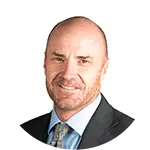

A major challenge for patients with depression is that traditional antidepressant medications often take weeks or months to show results — if they work at all. This delay can be especially distressing for those with severe depression symptoms, including suicidal thoughts.
To solve this issue, researchers and clinicians are continuously working on developing faster-acting depression treatments, one of the most promising being accelerated transcranial magnetic stimulation (TMS).
In this article, we cover the main factors patients should consider when choosing a clinic to receive accelerated TMS therapy:
Does the clinic offer MRI and/or neuronavigation for precise targeting and coil placement?
Does the clinic combine accelerated TMS therapy with psychotherapy or other treatments?
Cognitive FX offers the most advanced, safe, and precise method of accelerated TMS for people with treatment-resistant depression. Click here to learn more and see if you’re a good fit for treatment.
When exploring clinics for accelerated TMS treatment, it's crucial to recognize that "accelerated TMS" encompasses various protocols with differing speeds and effectiveness. Understanding these differences will help you clarify what each clinic offers, ensuring you receive the treatment you want.
In general, “accelerated TMS” refers to protocols that use intermittent theta-burst stimulation (iTBS). In contrast to the original and most common form of TMS (rTMS), which requires 37-minute daily treatment sessions over 4 to 6 weeks, iTBS can be delivered in just 3-minute sessions, making it much more convenient for patients. Typically, patients respond faster to iTBS than standard TMS therapy while achieving similar (or superior) results.
With that said, there are at least three accelerated TMS protocols that you might encounter:
One iTBS session per day over 4 to 6 weeks: TMS clinics may offer iTBS which provides the convenience of short 3-minute treatment sessions, but do so over the standard 4 to 6 week treatment period which can be difficult for many patients to adhere to due to work and life commitments. This protocol produces similar results to rTMS where about 50% of patients see improvement in symptoms and around 30% reach complete remission.
Multiple iTBS sessions per day over a condensed period: TMS centers may offer multiple iTBS sessions per day which condenses the time it takes to complete treatment by half or more.
Neuronavigated fMRI-Guided iTBS: A few clinics, including Cognitive FX, offer neuronavigated, fMRI-guided iTBS. Developed at Stanford University, this newly FDA-approved protocol uses iTBS in coordination with fMRI and neuronavigation for precision targeting (more on this below). SAINT™ treatment involves 10 sessions per day over 5 days for 50 sessions total. In a double-blind randomized clinical trial, about 85.7% of patients responded to the treatment (meaning they met prespecified criteria for reduced depressive symptoms) and around 78.6% met the remission criterion. All the individuals in the study had treatment-resistant depression and had failed at least two other depression treatments. At the one-month mark, 60% were still in remission. In addition, this protocol quickly reduces depressive symptoms and suicidal ideation within 5 days, without serious negative side effects.
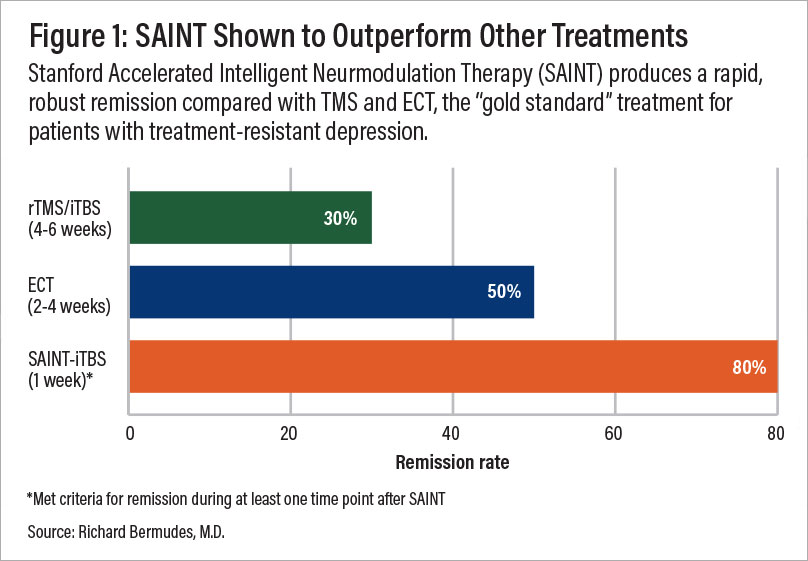
A comparison of remission rates for rTMS/iTBS, electroconvulsive therapy (ECT), and SAINT-iTBS.
When discussing options with TMS providers, ask them to clarify which accelerated treatment protocols they offer. This ensures you can choose a provider that meets your specific needs, whether you're looking for a condensed treatment schedule or cutting-edge options like accelerated fMRI-guided TMS, which offers a higher likelihood of rapid relief.
Aside from the condensed treatment time frame, the key thing that separates SAINT™ TMS from the other forms of accelerated TMS we discussed above is the use of fMRI for locating the target area of the brain (the dorsolateral prefrontal cortex or DLPFC), and neuronavigation for placing the magnetic coil over that exact spot on the patients head for every treatment session.
The reason this matters, and likely the key reason that fMRI-guided protocols produce significantly higher response and remission rates compared to standard rTMS or iTBS treatments, is that without fMRI and neuronavigation, the magnetic coil is often placed slightly off target. Even a few millimeters off can reduce the treatment’s effectiveness.
If the clinic you’re considering offers accelerated TMS that is not neuronavigated and fMRI-guided, this is when you want to ask about what method they use for targeting the DLPFC and placing the coil for each session.
Some clinics will offer a structural MRI (as opposed to fMRI) with neuronavigation. This would be second in line for ideal options. However, many clinics do not offer MRI or neuronavigation, and simply use one of the following methods for coil placement:
The 5 cm method (most common; least accurate): This method involves identifying an area on top of the head called the motor cortex. Operators locate this area using magnetic pulses, which force the patient’s thumb to move. Once the motor cortex is located, operators measure 5 cm along the parasagittal plane anterior to the activation hotspot in the motor cortex. Many studies now show that this method can be unreliable and doesn’t account for individual variations in brain size and shape between patients.
Beam F3 method (EEG Cap): This method relies on the International 10–20 EEG system to locate the DLPFC. Operators place a cap with a grid on the patient’s head and find position F3 to place the magnetic coil. Although studies show that the F3 method is slightly more accurate and reliable compared to the 5 cm method, differences are minor and unlikely to be substantially better. In addition, even a simple haircut can change how the cap fits the patient, which means it can vary from session to session.
If you can find a clinic that offers some form of MRI and neuronavigation, this is likely to give you the best treatment outcomes. If this isn’t an option for you, it can still be worth proceeding with treatment. Even standard forms of rTMS or accelerated TMS are likely to offer fewer side effects and equal or better results than antidepressant medications.
Note: For patients who have not responded to rTMS or accelerated TMS protocols that lacked MRI and neuronavigation, it is possible that they didn’t respond because the coil was in the wrong location. With the increased accuracy of fMRI, patients have a better chance of recovery.
Many clinics enhance the effectiveness of TMS by integrating it with other therapies, such as psychotherapy, neurofeedback, EMDR, or yoga. At our clinic, we believe that combining TMS with cognitive behavioral therapy (CBT) offers the greatest potential for improving long-term outcomes.
While TMS provides fast symptom relief, CBT has been shown to deliver more lasting benefits. Among the various forms of psychotherapy, CBT stands out with the strongest scientific backing for treating depression, supported by a substantial number of randomized controlled trials.
Meta-analyses consistently show that CBT outperforms other psychotherapies, particularly in maintaining benefits over time, with lasting effects up to a year or more post-treatment.
In contrast, other therapies and even medications often see a decline in effectiveness after treatment ends, with a higher risk of relapse.
Research clearly demonstrates that CBT surpasses other therapies and medications in both immediate and long-term outcomes for depression, with response rates ranging from 61% to 87% and consistently large effect sizes.
Be sure to ask clinics about any additional treatments they offer alongside TMS. If you're deciding between a clinic that provides only TMS and another that combines it with therapies like CBT, we recommend choosing the clinic with the integrated approach. For instance, at Cognitive FX, we offer CBT sessions to complement TMS, enhancing the overall effectiveness of the treatment.
Currently, accelerated TMS is not covered by insurance, which can be a major consideration when selecting a clinic. Only repetitive TMS (rTMS), used for depression since the 1990s, is typically covered, as many insurers deem it medically necessary for major depressive disorder (MDD) and treatment-resistant depression (TRD).
The cost of a TMS treatment course generally ranges from $6,000 to $15,000, and insurance coverage varies by provider. Some insurers require patients to have failed four antidepressant medications and psychotherapy, while others are less strict. Requirements for medication types and severity of symptoms also differ. Even with approval, patients may still face copays or deductibles, though some insurers may cover the full cost. For those needing further financial assistance, payment plans or healthcare financing options like CareCredit may help.
Advanced accelerated TMS protocols, such as SAINT™, are not covered by insurance and must be paid for out of pocket. These newer methods, particularly fMRI-guided protocols, offer significantly higher chances of getting response and remission.
If affordable, we recommend choosing a clinic offering these advanced treatments for the best chances of recovery. If relying on insurance, rTMS is still a viable option, offering equal or better results than antidepressant medication despite a longer treatment time and slightly lower response rates than accelerated TMS.
Our clinic in Provo, Utah, provides an alternative to SAINT™ TMS that offers the same precision of personalized treatment targeting, combined with FDA-approved theta burst stimulation at a significantly lower cost. This approach delivers the same core elements that make SAINT so revolutionary.
The only difference between our treatment and SAINT™ (a trademark licensed to Stanford Medical) is our targeting method. Our target locations are determined by fMRI and our prescribing neuroscientist and physician, rather than their proprietary software.
| Accelerated fMRI - TMS | Magnus SAINT™ TMS | |
|---|---|---|
| FDA-Approved iTBS | ✔ | ✔ |
| FDA-Approved Neuronavigators | ✔ | ✔ |
| FDA-Approved Figure 8 Coils | ✔ | ✔ |
| Number of Treatment Days | 5 | 5 |
| Treatments per Day | 10 | 10 |
| Total Treatments | 50 | 50 |
| Number of TMS Pulses | Approx. 90,000 | 90,000 |
| Resting motor threshold pulse intensity | 90–120% | 90–120% |
| FDA-Approved Personalized DLPFC Targeting | ✘ | ✔ |
| Personalized DLPFC Targeting Assists Doctor in Target Location | ✔ | ✘ |
| Personalized E Field Coil orientation | ✔ | ✘ |
| Cost | $9,000 to $12,000 | $30,000+ |
This accelerated TMS protocol is:
Safe: Widely tolerated and associated with mild, short-lasting side effects.
Precise: fMRI ensures that the treatment target area is precisely located for each patient, accounting for variations in head size and shape. Neuronavigation ensures the magnetic coil is placed over that exact spot for every treatment session.
Fast: Treatment courses are reduced to a single week, making it easier to complete alongside life and work commitments (compared to 4 to 6 weeks of standard TMS and accelerated TMS protocols).
Effective: Precision coil placement combined with theta burst stimulation produces the best TMS treatment results to date.
To improve patient outcomes, we also include cognitive behavioral therapy (CBT) as a part of our treatment. When combined with the traditional method of TMS (rTMS), CBT improved response and remission rates by ~8% and ~19%, respectively. Additionally, CBT is likely to produce sustained improvement over time once treatment has concluded.
Our brain stimulation treatment is ideal for most patients with treatment-resistant depression. However, we do not treat patients under the age of 18 or over 65. Additionally, as a safety measure, we do not treat patients who have a history of seizures or who are currently actively suicidal and in need of crisis care.
Click here to learn more about receiving accelerated fMRI TMS therapy at Cognitive FX.

Dr. Mark D. Allen holds a Ph.D. in Cognitive Science from Johns Hopkins University and received post-doctoral training in Cognitive Neuroscience and Functional Neuroimaging at the University of Washington. As a co-founder of Cognitive Fx, he played a pivotal role in establishing the unique and exceptional treatment approach. Dr. Allen is renowned for his pioneering work in adapting fMRI for clinical use. His contributions encompass neuroimaging biomarkers development for post-concussion diagnosis and innovative research into the pathophysiology of chronic post-concussion symptoms. He's conducted over 10,000 individualized fMRI patient assessments and crafted a high-intensity interval training program for neuronal and cerebrovascular recovery. Dr. Allen has also co-engineered a machine learning-based neuroanatomical discovery tool and advanced fMRI analysis techniques, ensuring more reliable analysis for concussion patients.
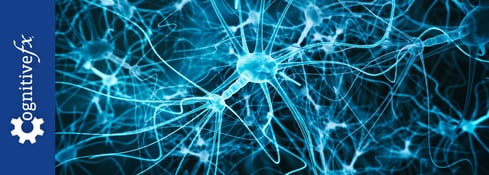
If you’re considering accelerated Transcranial Magnetic Stimulation (TMS) therapy, it’s important to understand how it works, what to expect, and whether it’s the right fit for you.
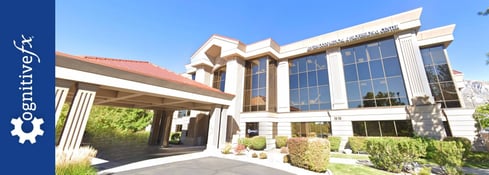
Suffering from treatment-resistant depression (TRD) is both common (you are not alone) and extremely difficult. It can feel incredibly discouraging when you’ve tried antidepressant medication or...
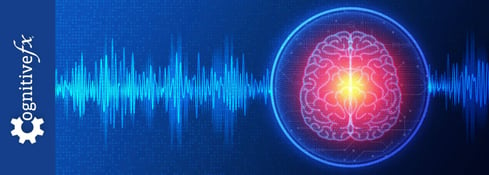
If you’re considering transcranial magnetic stimulation (TMS) therapy, you may be concerned about its side effects and whether the benefits outweigh any risks.

For many people living with major depression, antidepressant medications either don’t work or only get them part of the way to recovery. Symptoms may ease for a while, but then return, or never fully...

Transcranial magnetic stimulation (TMS) and neurofeedback are gaining popularity as non-invasive, medication-free options for treating depression—especially for people who haven’t found relief from ...

The type of protocol used is the most important factor influencing the price of TMS. Conventional TMS protocols are often the most affordable, while advanced protocols typically cost more, but can...